How to Apologize Before (and After) Breakfast:
A Chat with Illustrator Mike Wohnoutka
 May 4th, 2021 by jules
May 4th, 2021 by jules

David LaRochelle’s How to Apologize (Candlewick, May 2021), illustrated by Mike Wohnoutka, is a class-act primer on a difficult subject — how to say you’re sorry. It’s a challenge for even the best of humans to put their pride aside and accept and admit a wrong-doing. But David and Mike — and some gators, elephants, bulldogs, and meerkats — have your back in a book that covers it all: the universality of mistakes, the pain it can cause, how difficult it can be to apologize, why making excuses is a no-go, and much more. How do you apologize sincerely? What if the mistake happened eons ago? Should you try to fix your mistake? This book may be marketed for preschool to second-graders, but I know a lot of adults who could apply its emotionally astute wisdom to their own lives.
David and Mike are hardly new to collaboration: I happily direct you to this 2020 post for a book that eventually won the 2021 Geisel Award. Good things happen when they make books together. Today, Mike visits to talk about their work on How to Apologize and to share some process images. I thank him for visiting. Let’s get to it. …
 Jules: What was your first response to David’s text?
Jules: What was your first response to David’s text?
Mike (pictured left): David and I have been close friends since I joined his critique group 11 years ago. When David brought How to Apologize to one of our critique group meetings, I knew I wanted to be the illustrator. I thought it was brilliant, hilarious, and timely.
Since David is a very talented illustrator himself, I always feel a little silly telling him I want to illustrate one of his stories. But I told him anyway and was thrilled when he enthusiastically said he thought I would be the perfect illustrator for the book.
Jules: I know illustrators don’t normally converse with the author during the creation of the illustrations, but did you and David, by chance, imagine some of these scenarios together? Or were all of these ideas yours (extending his text with things like socks on a giraffe’s ears, a museum fiasco, and elderly tortoises)?
Mike: Normally, as the illustrator, I’ll only get the author’s manuscript from the publisher. So, all I have to work from are the words on the page.
That’s not the case with David. David will work up a book dummy with simple sketches. I use this as my starting point. David is the real genius here. I thought all of David’s scenarios in How to Apologize were spot-on, and I didn’t want to change any of them. The bottom line for both of us is to create the best book possible, so we both have to put our egos aside. David is open to text and story suggestions from me, and I did diverge from his original dummy in a few ways. For example, I changed some of the animals. I prefer to draw dogs and hippos over rabbits and ostriches.

(Click to enlarge)

(Click to enlarge)
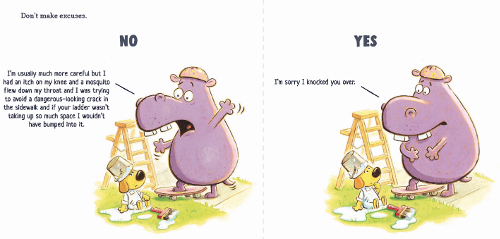
(Click to enlarge and read text in its entirety)
Also, it was decided early on that my illustrations would be double page spreads, rather than half-page illustrations, like in David’s dummy. Having more space to work with, I was able to elaborate on David’s sketches, such as in the museum fiasco spread.

(Click to enlarge)
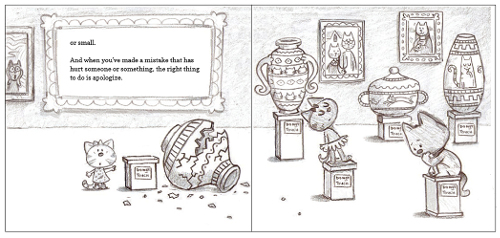
(Click to enlarge)

or something, the right thing to do is apologize.”
(Click to enlarge and read text in its entirety)
The double page spreads also allowed me to emphasize the scale of some of the animals, as in the rhino scene. You’ll also notice David’s monkeys turned into meerkats.
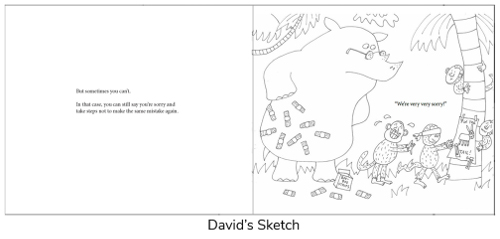
(Click to enlarge)
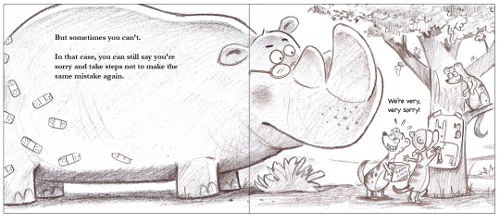
(Click to enlarge)
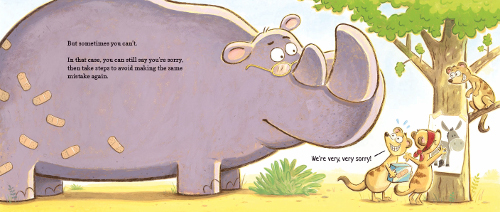
then take steps to avoid making the same mistake again.”
(Click to enlarge and read text in its entirety)
The last step of creating the final paintings is, for me, always the most challenging yet most fulfilling part.
Jules: You convey in these illustrations a lot of scenarios in which creatures misbehave. Did you end up with a lot of cut versions of scenarios on the drawing room floor?
Mike: David and I did collaborate on the cover. At one point, Candlewick was thinking that they wanted three illustrations on the cover: 1) the accident; 2) the “oops”/realization moment; and 3) the apology and/or the making-up. We brainstormed ideas together and came up with many different scenarios. I’m extremely happy with how the final cover turned out, but I was a little sad to see some of these scenes not make it into the final book.


(Click each to enlarge)
Jules: What is it that you like about working in gouache?
Mike: My first collaboration with David LaRochelle was Moo! This was also my first book using Acryla Gouache paint. Before Moo!, my 18 previous books were painted with acrylics, which meant more modeling and shading. I like that Acryla Gouache paint is very versatile. It’s more opaque than acrylics, so I can create a bold graphic style, which was perfect for Moo! or use it like watercolors with layers of washes, as I did in How to Apologize.

illustrated by Mike and painted with acrylics
(Click spread to enlarge)

Jules: Do you have a favorite spread in How to Apologize?
Mike: The sloth spread is my favorite painting in the book. I was really happy with how the background turned out — lots of transparent washes!

(Click spread to enlarge)
Jules: I see in your bio for this book that you once poured a carton of milk down the air vents of your third-grade classroom. What was that apology like?
Mike: That was a tough one. Not long after my best friend, Eric, and I poured our milk down the hole (two cartons!), there was a pounding on our classroom door. There at the door were five angry teachers, holding up their jackets that were drenched in milk. Our teacher, Mrs. Hjelle, looked directly at Eric and me. We sheepishly apologized and agreed to pay for the dry cleaning. I don’t think we actually ever paid them. Sorry!

Jules: Working on anything new that you can discuss now?
Mike: I just finished the sketches for See the Ghost: Three Stories About Things You Cannot See, written by David LaRochelle. This will be the third book in our See the Cat series. The second book from the series, See the Dog: Three Stories About a Cat comes out in September.

Jules: Yes! I saw David’s and your February 2021 chat with Betsy Bird about that one.
Mike: I’m also playing around with my own story ideas. I have a few concepts in various stages of completion.
Jules: Thanks for visiting, Mike!
HOW TO APOLOGIZE. Text copyright © 2021 by David LaRochelle. Illustrations copyright © 2021 by Mike Wohnoutka and reproduced by permission of the publisher, Candlewick Press, Somerville, MA. All other images reproduced by permission of Mike Wohnoutka.

Our friend Marjorie has an apology book for adults coming out – and another friend of mine has one as well – and here’s hoping we’ll need FEWER books for adults if the kids can read them first!!